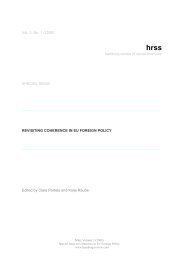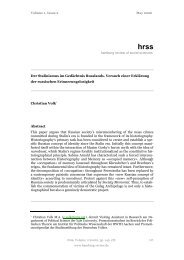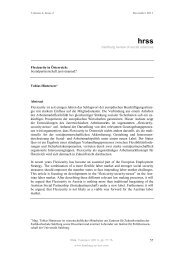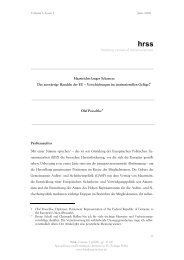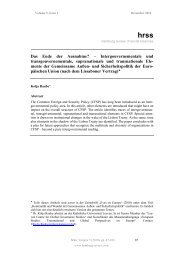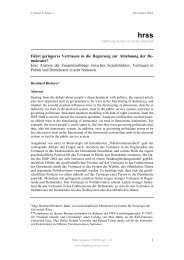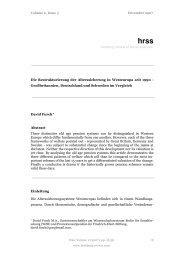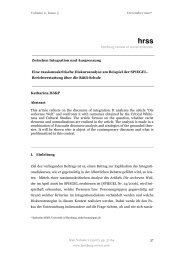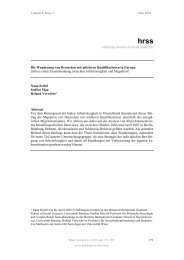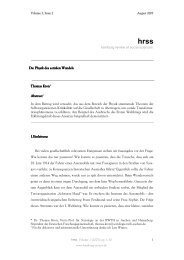A Introduction - Hamburg Review of Social Sciences
A Introduction - Hamburg Review of Social Sciences
A Introduction - Hamburg Review of Social Sciences
Create successful ePaper yourself
Turn your PDF publications into a flip-book with our unique Google optimized e-Paper software.
Volume 3, Issue 1 June 2008<br />
hrss<br />
hamburg review <strong>of</strong> social sciences<br />
Six Authors in Search <strong>of</strong> a Notion:<br />
(In)Coherence in EU Foreign Policy and its Causes<br />
Clara Portela and Kolja Raube ∗<br />
The foreign policies <strong>of</strong> the European Union (EU) has long been identified as a field <strong>of</strong><br />
special concern in the study <strong>of</strong> coherence due to the difficulty <strong>of</strong> overcoming the problems<br />
posed by its duality (M.E. Smith 2001:171). Fifteen years have elapsed since the Treaty on<br />
European Union (TEU) signed at Maastricht formally linked the external relations <strong>of</strong> the<br />
European Community (EC) and the intergovernmental Common Foreign and Security<br />
Policy (CFSP). Improving the coherence <strong>of</strong> EU (European Union) external action formulated<br />
in these two distinct foreign policy frameworks, or “pillars”, was a key motivation<br />
behind the establishment <strong>of</strong> a single institutional framework. The recent Commission’s<br />
Communication “Europe in the World – Some Practical Proposals for Greater Coherence,<br />
∗ Dr. Clara Portela is Researcher at the European University Institute, Florence, and Visiting Fellow<br />
at the Institute <strong>of</strong> Peace Research and Security Policy at the University <strong>of</strong> <strong>Hamburg</strong>.<br />
clara.portela@eui.eu. Dr. Kolja Raube is post-doc research assistant at the Institute <strong>of</strong> Political<br />
Science, University <strong>of</strong> <strong>Hamburg</strong>. raube@sozialwiss.uni-hamburg.de<br />
hrss, Volume 3 (2008), pp. 1-10<br />
Special Issue on Coherence in EU Foreign Policy<br />
www.hamburg-review.com<br />
1
Volume 3, Issue 1 June 2008<br />
Effectiveness and Visibility” shows that EU actors are concerned with coherence in daily<br />
foreign policy-making (Commission 2006).<br />
The present issue <strong>of</strong> the <strong>Hamburg</strong> <strong>Review</strong> <strong>of</strong> <strong>Social</strong> <strong>Sciences</strong> contributes to the exploration<br />
<strong>of</strong> (in)coherence in the foreign policies <strong>of</strong> the EU. The following lines provide a brief<br />
overview <strong>of</strong> the question <strong>of</strong> the definition <strong>of</strong> coherence before succinctly presenting the<br />
articles selected from those received in response to our open call for papers, and the guest<br />
article authored by Marise Cremona. In doing so, we highlight some <strong>of</strong> the themes most<br />
relevant to the latest institutional developments, as well as the innovations they bring to<br />
the debate on coherence.<br />
Coherence: An Elusive Notion<br />
Few notions in European foreign policy are characterised by such a high degree <strong>of</strong> complexity<br />
as the concept <strong>of</strong> “coherence”. The definition <strong>of</strong> this notion has been subject to<br />
different interpretations by the various scholars who have tackled the question. Indeed,<br />
the term “coherence” is regarded as having several meanings. The diversity <strong>of</strong> interpretations<br />
makes it necessary to open these introductory pages with a conceptual clarification.<br />
In the following lines, we summarise the various distinctions established around the definition<br />
<strong>of</strong> the term “coherence” and the classification <strong>of</strong> its subtypes.<br />
a/ One distinction pertains to the difference between coherence in terms <strong>of</strong> “institutional<br />
process” and “systemic output”. Christiansen defines coherence “in terms <strong>of</strong> systemic<br />
outputs” as “the way in which the substance <strong>of</strong> different policies generated by the<br />
EU forms part <strong>of</strong> a coherent whole”, while “coherence in terms <strong>of</strong> the institutional process<br />
by which policies are made” refers to “the degree to which institution(s) operate a coherent<br />
and well-coordinated process <strong>of</strong> deliberation and decision-making” (Christiansen<br />
2001:747). This distinction seems to coincide with the differentiation between “internal”<br />
and “external” coherence put forward by other authors. Yet, even the term “external coherence”<br />
appears to have a double meaning. While some scholars refer to it as the lack <strong>of</strong><br />
contradiction in the end product <strong>of</strong> policies framed in different frameworks (Sick 2001),<br />
other authors give this label to the uniform treatment <strong>of</strong> third countries by the EU (K.<br />
Smith 2003:65).<br />
hrss, Volume 3 (2008), pp. 1-10<br />
Special Issue on Coherence in EU Foreign Policy<br />
www.hamburg-review.com<br />
2
Volume 3, Issue 1 June 2008<br />
b/ Within “internal” or “institutional” coherence, further distinctions are made depending<br />
on where in the EU governance structure the tensions are located. When difficulties<br />
exist between the member states and the EU level scholars speak <strong>of</strong> “vertical” (Tietje<br />
1997:211) or “inter-level” consistency (Christiansen 2001:748). By contrast, difficulties<br />
in co-ordination between EU institutions are “horizontal” and can be further subdivided<br />
into “intra-pillar” or “inter-pillar” coherence, depending on whether they occur in<br />
the relationship between the Community and the intergovernmental pillars or within the<br />
same pillar. This category, which gives expression to a challenge specific to the EU’s institutional<br />
set up, can also be labelled “inter-institutional” coherence. Problems <strong>of</strong> coherence<br />
have been identified at all levels mentioned (Christiansen 2001). To the detriment<br />
<strong>of</strong> conceptual clarity, some authors have referred to the maintenance <strong>of</strong> coherence between<br />
the Community and the CFSP pillars as “institutional coherence” (Nuttall 2005),<br />
which overlaps with Christiansen’s label for the internal coherence <strong>of</strong> the EU policy formulation<br />
process.<br />
c/ Perhaps the most central conceptual problem in the definition <strong>of</strong> coherence is the<br />
delimitation <strong>of</strong> “coherence” versus “consistency”, a distinction which is respected by certain<br />
scholars and dismissed by others. The absence <strong>of</strong> uniform terminology is compounded<br />
by diverging translations <strong>of</strong> the TEU: While the English translation favours the term<br />
“consistency”, most continental languages employ the term “coherence”. This conceptual<br />
distinction has been elaborated by legal and political science scholars alike, who tend to<br />
see consistency as the mere “absence <strong>of</strong> contradiction”, while the notion <strong>of</strong> coherence appears<br />
to go beyond sheer compatibility to convey the idea <strong>of</strong> mutual reinforcement <strong>of</strong><br />
policies, defined as “synergy” (Gauttier 2004:26) or the establishment <strong>of</strong> “positive connections”<br />
(Tietje 1997:212). Obviously, this notion sets a higher standard for EU policies<br />
(M.E. Smith 2001:173) and is far more difficult to grasp conceptually than the mere “absence<br />
<strong>of</strong> contradiction”.<br />
In sum, this fragmentation confronts the student <strong>of</strong> coherence with a scenario <strong>of</strong> quod capita,<br />
tot sensus. In view <strong>of</strong> the lack <strong>of</strong> a unitary definition, the contributors to this special<br />
issue have each defined their individual understanding <strong>of</strong> coherence, choosing the definition<br />
that best suits the analytical purposes <strong>of</strong> their respective articles. As editors we<br />
adopted the definition put forward by Krenzler and Schneider who conceive <strong>of</strong> coherence<br />
hrss, Volume 3 (2008), pp. 1-10<br />
Special Issue on Coherence in EU Foreign Policy<br />
www.hamburg-review.com<br />
3
Volume 3, Issue 1 June 2008<br />
as “coordinated behaviour based on agreements among the Union and its member states,<br />
where comparable and compatible methods are used in pursuit <strong>of</strong> a single objective and<br />
result in an uncontradictory policy” (1997: 134). We opted for this definition due to its<br />
all-encompassing character, as it is capable <strong>of</strong> accommodating the aforementioned subcategories.<br />
Ensuring Coherence through Legal-institutional Design<br />
The need to ensure coherence in EU policies was identified as early as the mid-seventies,<br />
at an initial stage in the development <strong>of</strong> foreign policy co-ordination outside the Community<br />
framework (Nuttall 2005:94). Yet, the solution proposed at the time consisted <strong>of</strong> exhortations<br />
calling on EU actors to maintain coherence, which was introduced in the treaties<br />
for the first time in 1986. The Single European Act stipulates that “the external policies<br />
<strong>of</strong> the European Community and the policies adopted by the European Cooperation<br />
Policy shall be consistent” (§30(5)). The TEU was the first treaty revision to put in place<br />
a number <strong>of</strong> institutional arrangements to address shortcomings in coherence. At Maastricht,<br />
and later Amsterdam, an attempt was made to tackle coherence problems at three<br />
levels:<br />
1/ One level concerned bureaucratic-institutional reforms. These ranged from the creation<br />
<strong>of</strong> the single institutional framework, which provided for the use <strong>of</strong> common institutions<br />
in all pillars, to the reorganisation <strong>of</strong> the Commission’s administrative apparatus.<br />
2/ The second level included the double-hatting <strong>of</strong> senior posts in the EU institutional set<br />
up, notably through the appointment <strong>of</strong> a High Representative <strong>of</strong> the CFSP who is simultaneously<br />
Secretary-General <strong>of</strong> the Council Secretariat and <strong>of</strong> the Western European Union.<br />
3/ A third level concerned the establishment <strong>of</strong> legal instruments within the second pillar<br />
meant to co-ordinate external action by EU actors, namely the Common Positions and<br />
Joint Actions, which would be complemented by Common Strategies in the Amsterdam<br />
revision.<br />
hrss, Volume 3 (2008), pp. 1-10<br />
Special Issue on Coherence in EU Foreign Policy<br />
www.hamburg-review.com<br />
4
Volume 3, Issue 1 June 2008<br />
Subsequent treaty reforms have endeavoured to perfect such arrangements. In fact, the<br />
continued preoccupation with improving the system was not only driven by its perceived<br />
insufficiency but also by the progressive growth and increasing specialisation <strong>of</strong> its bureaucratic<br />
units (Christiansen 2001). Yet, despite some improvements the institutional formulae<br />
have proved <strong>of</strong> limited use in averting incoherence in the EU’s steadily increasing foreign<br />
policy activity (M.E. Smith 2001:171). In the face <strong>of</strong> the insufficiency <strong>of</strong> arrangements<br />
developed at or in the follow-up to Maastricht, what solutions have EU actors developed<br />
in order to ensure coherence?<br />
The two initial contributions <strong>of</strong> this issue illuminate this question. In her opening article,<br />
Marisa Cremona provides an account <strong>of</strong> the fundamental role the EU legal order plays<br />
in ensuring coherence in EU foreign policy. Probably because legal scholars and political<br />
scientists tend to approach the study <strong>of</strong> coherence separately, non-jurists <strong>of</strong>ten analyse<br />
coherence from the perspective <strong>of</strong> bureaucratic politics and institutional design without<br />
considering the EU legal system’s fundamental role in ensuring coherence. Marise Cremona’s<br />
central contribution consists in highlighting how both jurisprudence by the European<br />
Court <strong>of</strong> Justice and treaty reform – most recently the Treaty <strong>of</strong> Lisbon – have accentuated<br />
the separation <strong>of</strong> powers between the national and EU level on the one hand<br />
and the Community and CFSP pillar on the other by delineating their tasks even more<br />
clearly than before.<br />
Olaf Poeschke, a practitioner, shows in a subsequent contribution how the trend towards<br />
a stricter separation <strong>of</strong> powers is evident in the day-to-day management <strong>of</strong> areas<br />
where Council and Commission competencies intersect. Here, codification has followed<br />
the establishment <strong>of</strong> practices, a phenomenon <strong>of</strong>ten witnessed in the institutional development<br />
<strong>of</strong> the EU. In his analysis <strong>of</strong> inter-pillar coherence in selected foreign policy tools,<br />
he finds that the predominant trend is to strengthen the delimitation <strong>of</strong> competences between<br />
Council and Commission, rather than to formulate solutions in which co-operation<br />
overcomes legal distinctions. Even the appointment <strong>of</strong> a Special Representative to Macedonia,<br />
who is simultaneously the Head <strong>of</strong> the Commission Delegation, is founded on a<br />
clearly dual mandate, an expression <strong>of</strong> the aforementioned separation <strong>of</strong> competences.<br />
The increased reliance on the double-hatting <strong>of</strong> personnel is one <strong>of</strong> the main innovations<br />
brought about by the Treaty to ensure coherence. This not only concerns the high-level<br />
posts <strong>of</strong> the High Representative and Special Representatives, but also the prospective<br />
hrss, Volume 3 (2008), pp. 1-10<br />
Special Issue on Coherence in EU Foreign Policy<br />
www.hamburg-review.com<br />
5
Volume 3, Issue 1 June 2008<br />
External Action Service. It is remarkable that from the catalogue <strong>of</strong> instruments explored<br />
by Poeschke, the operation <strong>of</strong> the mechanism for the imposition <strong>of</strong> economic sanctions –<br />
a time-honoured arrangement which predates the Maastricht reforms – emerges as a<br />
unique instance <strong>of</strong> smooth, if not totally friction-free, inter-pillar collaboration.<br />
Beyond the strengthening <strong>of</strong> the separation <strong>of</strong> competences, a further trend with a major<br />
bearing on coherence is singled out by our authors. The moribund “CFSP Common<br />
Strategies”, an instrument whose clear purpose was to orchestrate policies by the EU and<br />
member states, has been finally replaced by a more flexible solution. In the future, the<br />
European Council rather than the Council <strong>of</strong> Ministers will decide on “strategies”, and<br />
they will be only politically binding. The European Security Strategy and the EU Strategy<br />
against the Proliferation <strong>of</strong> Weapons <strong>of</strong> Mass Destruction <strong>of</strong> 2003 can be seen as a “forerunners”.<br />
On the one hand, the disappearance <strong>of</strong> the Common Strategies can be viewed<br />
as an indication that CFSP arrangements need to be “piloted” in practice before being<br />
codified in order to ensure their practicability.<br />
But in terms <strong>of</strong> institutional coherence, this development denotes a reversal from the<br />
path towards the progressive integration <strong>of</strong> EU foreign policies with those <strong>of</strong> the member<br />
states. The highest intergovernmental instance, the European Council, strengthens its position<br />
not only as “final arbiter” but as a co-ordinating entity. The reinforcement <strong>of</strong> the<br />
separation <strong>of</strong> powers described by Cremona and Poeschke can be interpreted as a failure<br />
<strong>of</strong> the idea <strong>of</strong> “coherence” as originally foreseen by the Treaty <strong>of</strong> Maastricht. At the time,<br />
the hope was that institutions could co-operate in “grey areas” where competences were<br />
not clearly delineated. By sharpening the delimitation <strong>of</strong> competences, the EU implicitly<br />
acknowledges that synergy in areas <strong>of</strong> overlap is unworkable. As Christiansen suggested in<br />
the aftermath <strong>of</strong> the Nice Treaty, a “clearer separation <strong>of</strong> powers” contradicts “institutional<br />
coherence” (Christiansen 2001:749).<br />
Yet, a glance at a lower level <strong>of</strong> policy formulation shows that the Commission sometimes<br />
does gain the upper hand. CFSP Common Strategies have been replaced by European<br />
Council “strategies” deprived <strong>of</strong> legal character, but at a meso- and micro level it is<br />
the ENP Action Plans that are fulfilling this function. Elsa Tulmets explains in her contribution<br />
how the Council has relinquished responsibility for the European Neighbourhood<br />
Policy (ENP) into the hands <strong>of</strong> the Commission. In its turn, Tulmets’ analysis <strong>of</strong> the ENP<br />
also reveals a coherent management <strong>of</strong> policy instruments which appears to have emerged<br />
hrss, Volume 3 (2008), pp. 1-10<br />
Special Issue on Coherence in EU Foreign Policy<br />
www.hamburg-review.com<br />
6
Volume 3, Issue 1 June 2008<br />
by means which diverge from those foreseen by the institutional designs described above.<br />
Rather, ENP practices have been perfected in the course <strong>of</strong> the Commission’s experience<br />
with Eastern enlargement and subsequently adjusted to the ENP framework through policy<br />
transfer.<br />
Coherence as “Explanandum”<br />
The contributions by Tulmets, Stahl and Alcalde and Bouchard reflect a departure from<br />
the emphasis on bureaucratic politics that has so far dominated political science accounts<br />
<strong>of</strong> incoherence. The notion <strong>of</strong> “coherence” appears to have transcended the boundaries <strong>of</strong><br />
bureaucratic theory to become a category <strong>of</strong> general currency in the study <strong>of</strong> foreign policy.<br />
Despite the heterogeneity that the three contributions display in terms <strong>of</strong> focus and<br />
approaches, they all treat coherence as an independent rather than a dependent variable.<br />
The contributions by Tulmets, Stahl and Alcalde and Bouchard try to explain incoherence<br />
by analysing different fields <strong>of</strong> EU foreign policy. Moreover, the three articles reveal<br />
the usefulness <strong>of</strong> investigating the concepts <strong>of</strong> agency and structure in European foreign<br />
policy. The significance <strong>of</strong> agency, which points to key actors capable <strong>of</strong> bring about coherence,<br />
is highlighted in the articles by Tulmets and Alcalde and Bouchard. By contrast,<br />
structure refers to underlying differences <strong>of</strong> structural nature among EU actors, typically<br />
member states, as discussed by Stahl.<br />
The central innovation in Bernhard Stahl’s contribution is that it illuminates the<br />
sources <strong>of</strong> incoherence. It is unique in that it highlights an <strong>of</strong>ten overlooked root <strong>of</strong> incoherence.<br />
The intra-European debacle over the US-inspired invasion <strong>of</strong> Iraq, the most<br />
prominent example <strong>of</strong> member states’ lack <strong>of</strong> co-ordination in the past decades (Risse<br />
2003; Peterson 2004) and arguably also the main setback to the CFSP since its inception,<br />
serves as the case-study. By elucidating the causes that led to this high-pr<strong>of</strong>ile CFSP failure,<br />
Stahl exposes an aspect <strong>of</strong> incoherence which institutional devices can address only<br />
partially, if at all. The institutional arrangements devised to ensure vertical coherence are<br />
meant to help overcome differences among its constituent units, the member states. However,<br />
the process <strong>of</strong> “inconsistent securitisation” that took place across EU member states<br />
on the eve <strong>of</strong> the Iraq invasion illustrates that the likelihood <strong>of</strong> (in)coherent outputs is<br />
hrss, Volume 3 (2008), pp. 1-10<br />
Special Issue on Coherence in EU Foreign Policy<br />
www.hamburg-review.com<br />
7
Volume 3, Issue 1 June 2008<br />
strongly influenced by domestic factors. Hence, uneven securitisation in the member states<br />
remains a structural “deficit”.<br />
Tulmets’ article features an analysis <strong>of</strong> the newly-branded Neighbourhood Policy, a<br />
domain <strong>of</strong> EU external activity which has attracted a considerable amount <strong>of</strong> attention<br />
since its launching in 2003. Thanks to her differentiation between internal and external<br />
dimensions, Tulmets analyses the coherence both <strong>of</strong> the decision-making process and its<br />
output. She identifies what one might call a tw<strong>of</strong>old “learning-process”: The European<br />
Council understood that ENP would benefit from the delegation <strong>of</strong> policy-making powers<br />
to the Commission. In turn, the Commission could usefully apply the institutional expertise<br />
acquired in the course <strong>of</strong> the successful Eastern enlargement. While internal coherence<br />
in the ENP is widely acknowledged, external coherence – understood as consistency<br />
in the treatment <strong>of</strong> third-countries – still raises questions.<br />
In a final article, Javier Alcalde and Caroline Bouchard touch upon the question <strong>of</strong> external<br />
representation <strong>of</strong> the EU in multilateral settings. The external representation <strong>of</strong> the<br />
EU has been a matter <strong>of</strong> concern to the architects <strong>of</strong> the single institutional framework<br />
since its inception. Alcalde and Bouchard also point to agency and its influence on coherence.<br />
In their investigation <strong>of</strong> multi-level-negotiations at the <strong>Review</strong> Conference on Small<br />
Arms and Light Weapons (SALW) <strong>of</strong> 2006, they distinguish a dimension <strong>of</strong> coherence<br />
distinct from the classical categories: “content/representation”. At the conference, a<br />
number <strong>of</strong> member states lobbied for different priorities. Although these objectives were<br />
part <strong>of</strong> a pre-agreed “strategy”, the fact that different member states did not pursue identical<br />
goals undermined the collective lobbying efforts. This formula might have been<br />
workable as a lobbying-strategy, and it might even have been deliberate. Yet, it was perceived<br />
as confusing by other parties, which can only conceive <strong>of</strong> the EU as a unitary actor<br />
as long as it speaks with “a single voice”. “Being coherent” does not suffice, member states<br />
also need to “appear coherent”.<br />
Beyond the Search <strong>of</strong> a Notion<br />
With the exception <strong>of</strong> Marise Cremona’s article, the contributions to this Special Issue<br />
resulted from an open call. They reflect a growing interest in the (unresolved) question <strong>of</strong><br />
coherence. Despite the heterogeneity <strong>of</strong> the featured articles, on the whole they provide a<br />
hrss, Volume 3 (2008), pp. 1-10<br />
Special Issue on Coherence in EU Foreign Policy<br />
www.hamburg-review.com<br />
8
Volume 3, Issue 1 June 2008<br />
stimulating mosaic <strong>of</strong> diverse aspects <strong>of</strong> (in)coherence in EU foreign policy. The articles<br />
by Stahl, Tulmets, Alcalde and Bouchard depart from the classical bureaucratic/institutional<br />
approach traditionally applied to the study <strong>of</strong> coherence, pursuing an<br />
innovative strand recently inaugurated by a handful <strong>of</strong> scholars (Lerch/Schwellnus 2006;<br />
Szymannski/M.E. Smith 2006; Stetter 2007). This comes as a welcome complement to the<br />
works which, like Cremona and Poeschke, identify the implications for the coherence <strong>of</strong><br />
legal-institutional dynamics in the EU. Our understanding <strong>of</strong> coherence can be considerably<br />
aided by the innovative trajectories pursued by our authors.<br />
This brief overview by no means fully explicates the contributions made by the authors<br />
to the study <strong>of</strong> coherence, and to field <strong>of</strong> European foreign policy in general. We are certain<br />
that readers <strong>of</strong> this issue will appreciate the wealth <strong>of</strong> insights in the featured articles<br />
without further introduction. Finally, we wish to conclude this introductory note by expressing<br />
our gratitude to the six authors who have made possible this special issue, and to<br />
the anonymous reviewers for their invaluable help. We would also like to thank Stephan<br />
Stetter and Emma J. Stewart for their assistance on the final product. We remain indebted<br />
to all <strong>of</strong> them for their dedication and patience.<br />
References<br />
Christiansen, T. (2001) “Intra-institutional politics and inter-institutional relations in the<br />
EU: towards coherent governance?”, Journal <strong>of</strong> European Public Policy, 8(5)<br />
European Commission (2006) Europe in the World – Some Practical Proposals for Greater<br />
Coherence, Effectiveness and Visibility (Communication from the Commission to the<br />
European Council <strong>of</strong> June 2006). COM (2006) 278 final<br />
Gauttier, P. (2004) “Horizontal Coherence and the External Competencies <strong>of</strong> the European<br />
Union” European Law Journal, 10(1)<br />
Krenzler, H.G. and Schneider, H.C. (1997) “The Question <strong>of</strong> Consistency” in: E. Regelsberger,<br />
P. de Schoueete de Tervaren, and W. Wessels (eds) Foreign Policy <strong>of</strong> the<br />
European Union. From EPC to CFSP and beyond. Lynne Rienners: London<br />
Lerch, M. and Schwellnus, G. (2006) “Normative by Nature? The Role <strong>of</strong> Coherence in<br />
Justifying the EU’s External Human Rights Policy” in H. Sjursen (ed.) Civilian or<br />
Military Power? European Foreign Policy in Perspective. London: Routledge<br />
Nuttall, S. (2005) “Coherence and Consistency” in Ch. Hill and M. Smith (eds) The<br />
European Union and International Relations, Oxford University Press: Oxford<br />
hrss, Volume 3 (2008), pp. 1-10<br />
Special Issue on Coherence in EU Foreign Policy<br />
www.hamburg-review.com<br />
9
Volume 3, Issue 1 June 2008<br />
Sick, S. (2001) “Das Kohärenzgebot bei Wirtschaftssanktionen der EU – Zum Verständnis<br />
zwischen Gemeinsamer Außen- und Sicherheitspolitik und gemeinschaftlicher<br />
Handelspolitik“, Nomos: Baden-Baden<br />
Smith, K. (2003) European Foreign Policy in a Changing World, Polity: London<br />
Smith, M.E. (2004) „The Quest for Coherence“ in A. Stone Sweet, W. Sandholz and N.<br />
Fligstein (eds) The Institutionalisation <strong>of</strong> Europe, Oxford University Press: Oxford<br />
Stetter, S. (2007) EU Foreign and Interior Policies, Routledge: London<br />
Szymanski, M. and Smith, ME. (2006) “Coherence and Conditionality in European Foreign<br />
Policy: Negotiating the EU-Mexico Global Agreement”, in Journal <strong>of</strong> Common<br />
Market Studies, Vol. 43, 171-192.<br />
Tietje, Ch. (1997) „The Concept <strong>of</strong> Coherence in the Treaty on European Union and the<br />
Common Foreign and Security Policy”, European Foreign Affairs <strong>Review</strong> 2(1).<br />
hrss, Volume 3 (2008), pp. 1-10<br />
Special Issue on Coherence in EU Foreign Policy<br />
www.hamburg-review.com<br />
10



